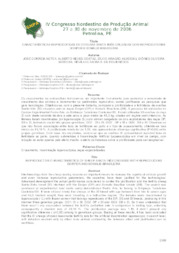Características reprodutivas de ovelhas Santa Inês cruzadas com reprodutores Dorper e Somalis brasileira.
Características reprodutivas de ovelhas Santa Inês cruzadas com reprodutores Dorper e Somalis brasileira.
Author(s): CORREIA NETO, J.; COSTA, A. N.; ALMEIDA, S. A.; SANTOS, D. O.; SALLES, H. O.
Summary: Os cruzamentos na ovinocultura tornaram-se um importante instrumento para aumentar a velocidade de crescimento dos animais e incrementar os parâmetros reprodutivo, sendo justificadas as pesquisas que gere tecnologias. Objetivou-se, com o presente trabalho, comparar a prolificidade e a fertilidade, de ovelhas Santa Inês (SI) cruzados com as raças Dorper (DP) e Somalis Brasileira (SB). A pesquisa foi conduzida no Campo Experimental Pedro Arle, da Embrapa Tabuleiros Costeiros/SE. Foram utilizadas 95 ovelhas da raça SI com idade variando de dois a sete anos e peso médio de 45,3 kg, criadas em regime semi-intensivo. As fêmeas foram inseminadas por laparoscopia (IL) com sêmen congelado de dois reprodutores das raças DP, SB e SI, formando assim três grupos genéticos: GG1 : SI x SI, GG2 : DP x SI e GG3 : SB x SI. Observou-se que não houve associação entre taxa de fertilidade ao parto e o tipo de acasalamento, obtendo-se taxa média de 43,16 %. A prolificidade média foi de 1,19, não apresentando diferença significativa (P>0,05) entre grupos genéticos. Com base nos resultados, conclui-se que as ovelhas SI apresentaram razoável taxa de fertilidade ao parto, quando submetidas à Inseminação Artificial Laparoscópica em nível de campo, com indução do estro apenas pelo efeito macho; o efeito da heterose sobre a prolificidade pode ser desprezível. Reproductive characteristics of sheep Santa Inês crossed with reproducers Dorper and Somalis Brasileira. Abstract - Interbreedings from the sheep raising become an important means to increase the rapidity of animals growth and even increase reproductive parameters, the searches have been justified for the technological. Advanced development the actual performance considered to confer the prolification and the fertility sheep Santa Snês breed (SI) interbred with the Dorper (DP) and Somalis Brazilian breeds (SB). The search was conduced at experimental rural rustic camp denominated Pedro Arle, to belong to Embrapa Tabuleiros Costeiros/SE. It were utilized ninety five sheeps of the SI breed with age between from two to seven ages and 45,3 medium weight, they were breeding in a half-active regime. The females were inseminated by laparoscopia ( IL) with frozen semen that belongs reproducers of the DP, SB and SI breeds, producing in this manner three genetical groups: GG1: SI x SI, GG2: DP x SI and GG3: SB x SI. So it was understood that there wasn´t any association between the fertility parturition rate in comparison to mating type, obtaining consequently a medium rate of 43,16 %. The prolification average was 1,19, it didn´t present any significative diference ( p>0,05) among to geneticals groups. Basing at these results, it has been concluded that the SI sheeps showed reasonable fertlility rate for the artificial insemination laparoscopic in search level, with induction oestrum only by effect male animal; contrasting the heterose effect and prolification can be worthless.
Publication year: 2006
Types of publication: Paper in annals and proceedings
Unit: Embrapa Goats & Sheep
Observation
Some of Embrapa's publications are published as ePub files. To read them, use or download one of the following free software options to your computer or mobile device. Android: Google Play Books; IOS: iBooks; Windows and Linux: Calibre.
Access other publications
Access the Agricultural Research Database (BDPA) to consult Embrapa's full library collection and records.
Visit Embrapa Bookstore to purchase books and other publications sold by Embrapa.

